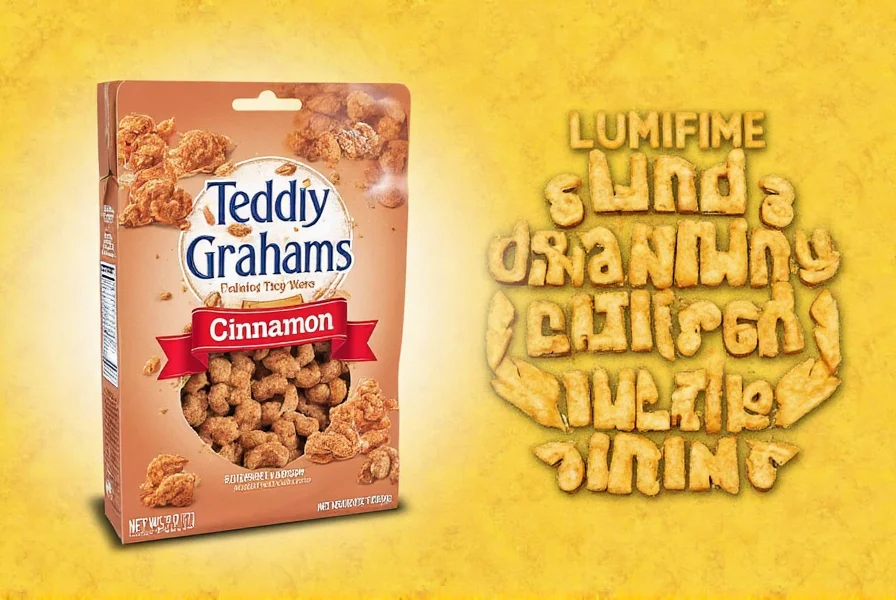Cinnamon Teddy Grahams have become a staple in pantries across North America since their introduction as part of the beloved Teddy Grahams product line. These distinctive bear-shaped crackers offer a sweet yet subtly spiced flavor profile that distinguishes them from the original honey variety. Understanding what makes these snacks special requires examining their composition, nutritional value, and versatile applications beyond simple snacking.
Product History and Development
Originally introduced by Nabisco in the 1980s, Teddy Grahams were designed as a fun, bear-shaped alternative to traditional graham crackers. The cinnamon variety emerged later as consumer demand grew for more flavor options beyond the original honey version. In 2014, Mondelēz International (which acquired Nabisco) reformulated several Teddy Grahams varieties to remove high-fructose corn syrup and artificial ingredients, responding to changing consumer preferences for cleaner ingredient lists. This reformulation particularly benefited the cinnamon teddy grahams ingredients list, making it more appealing to health-conscious parents.
Ingredient Composition and Nutritional Profile
The cinnamon teddy grahams nutrition facts reveal a relatively simple composition compared to many processed snacks. Each serving (about 13 crackers or 30g) typically contains:
| Nutrient | Amount per Serving | % Daily Value |
|---|---|---|
| Calories | 120 | - |
| Total Fat | 3.5g | 4% |
| Saturated Fat | 0g | 0% |
| Trans Fat | 0g | 0% |
| Cholesterol | 0mg | 0% |
| Sodium | 140mg | 6% |
| Total Carbohydrate | 22g | 8% |
| Dietary Fiber | 2g | 7% |
| Total Sugars | 6g | - |
| Included Added Sugars | 5g | 10% |
| Protein | 2g | - |
The primary ingredients include whole grain wheat flour, sugar, canola oil, and a cinnamon flavor blend. Unlike many children's snacks, cinnamon teddy grahams contain no high-fructose corn syrup, artificial flavors, or artificial colors. The cinnamon flavor comes from natural spices rather than artificial cinnamon flavoring, contributing to their distinctive warm taste.

Versatile Serving Suggestions
While delicious on their own, cinnamon teddy grahams shine when incorporated into creative snack combinations. Parents seeking healthy cinnamon teddy grahams snack ideas often pair them with:
- Apple slices or banana pieces for a balanced sweet and crunchy combination
- Almond butter or peanut butter for added protein
- Yogurt for a parfait-style treat
- Cheese cubes for a satisfying sweet-savory contrast
- Mixed with dried fruit for a homemade trail mix
For baking enthusiasts, these crackers work well as a crust ingredient for no-bake desserts or crumbled as a topping for ice cream. Their sturdy texture holds up well in recipes requiring a graham cracker substitute, making them valuable for cinnamon teddy grahams recipe applications beyond simple snacking.
Comparison with Other Teddy Grahams Varieties
When considering cinnamon teddy grahams vs honey teddy grahams, several key differences emerge:
- Flavor profile: Cinnamon offers a warm, spicy note while honey provides a sweeter, floral taste
- Sugar content: Cinnamon variety contains slightly less sugar (5g vs 6g of added sugar per serving)
- Color: Cinnamon bears have a light brown hue compared to the golden color of honey variety
- Seasonal availability: Cinnamon flavor often sees increased production during fall and winter months
Both varieties maintain the same bear-shaped design and whole grain content, but the cinnamon version has developed a dedicated following among consumers who prefer its more complex flavor profile. Some parents report that children who are sensitive to overly sweet snacks often prefer the cinnamon teddy grahams for kids due to their less sugary taste.
Storage Recommendations and Shelf Life
Proper cinnamon teddy grahams storage tips can significantly extend their freshness and crisp texture. The resealable packaging helps, but for optimal results:
- Store in a cool, dry place away from direct sunlight
- Ensure the package is completely sealed after each use
- Consider transferring to an airtight container for longer storage
- Avoid humid environments which can make the crackers soft
When properly stored, unopened packages maintain peak quality for 9-12 months from production date. Once opened, they typically remain fresh for 2-3 weeks. For extended storage, placing the sealed package in the refrigerator can help maintain crispness for up to 6 weeks. Freezing is generally not recommended as it can affect texture.
Consumer Reception and Market Position
Cinnamon Teddy Grahams have developed a loyal following since their introduction, particularly among parents seeking snacks with simpler ingredients. Market research indicates they consistently rank as one of the top three most popular Teddy Grahams varieties, alongside the original honey and chocolate varieties.
Consumer reviews frequently highlight the balance of sweet and spice, the satisfying crunch, and the absence of artificial ingredients as key selling points. Many parents appreciate that cinnamon teddy grahams for kids provide a familiar snack option that feels slightly more sophisticated than purely sweet alternatives.

Where to Find Cinnamon Teddy Grahams
These snacks are widely available at most major grocery stores, typically found in the cookie or children's snack aisle. Larger retailers often carry them in both single-serve packs and family-sized boxes. While specific where to buy cinnamon teddy grahams locations may vary by region, they're generally stocked year-round with potential seasonal increases during back-to-school and holiday periods.
Online retailers also offer cinnamon Teddy Grahams, though shipping costs for this lightweight but bulky product may make in-store purchase more economical. Some specialty food stores carry them as part of their natural or organic snack selections, particularly those focusing on products without artificial ingredients.
Frequently Asked Questions
Are cinnamon Teddy Grahams gluten-free?
No, cinnamon Teddy Grahams are not gluten-free as they contain whole grain wheat flour. They are made in facilities that process wheat and may contain gluten traces even in varieties labeled otherwise.
How many cinnamon Teddy Grahams constitute a serving size?
A standard serving size of cinnamon Teddy Grahams is approximately 13 bear-shaped crackers, which equals 30 grams or about 1 ounce. This serving provides 120 calories and 5 grams of added sugar.
Do cinnamon Teddy Grahams contain dairy or nuts?
The standard cinnamon Teddy Grahams formulation does not contain dairy or nuts as ingredients. However, they are produced in facilities that process milk and tree nuts, so there may be potential for cross-contamination. Always check the specific package for allergen information.
What's the difference between cinnamon Teddy Grahams and cinnamon graham crackers?
Cinnamon Teddy Grahams are bear-shaped snacks with a specific cinnamon flavor profile, while traditional cinnamon graham crackers are larger, rectangular crackers often used for pie crusts. Teddy Grahams have a lighter texture and are marketed specifically as children's snacks, whereas graham crackers serve broader culinary purposes.
Are cinnamon Teddy Grahams considered a healthy snack option?
Compared to many children's snacks, cinnamon Teddy Grahams offer a relatively clean ingredient profile without high-fructose corn syrup or artificial flavors. While not a health food, they provide whole grains and can be part of a balanced diet when paired with protein or fruit. Moderation is key, as they do contain added sugar.











 浙公网安备
33010002000092号
浙公网安备
33010002000092号 浙B2-20120091-4
浙B2-20120091-4